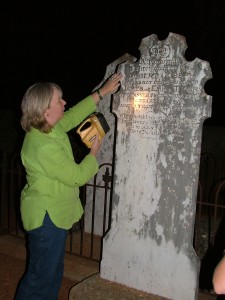Vincent Ross explores the town cemetery of Burra in South Australia and discovers tales of fascinating deaths and tragic stupidity.
 If you smoke, it’s probably not wise to ask for a light in Burra – in this South Australian town, smoking is traditionally a health hazard.
If you smoke, it’s probably not wise to ask for a light in Burra – in this South Australian town, smoking is traditionally a health hazard.
The habit took 24-year-old English seaman John Smith in his prime, and completely by surprise, but not quite in the way you might expect.
He had his head split in two with an axe.
Poor John lies under a simple headstone, paid for with a collection taken up by his fellow seamen after his grizzly death.
His is just one of many intriguing stories unearthed on a twilight tour of Burra Cemetery, the final resting place of more than a few Cornish miners and sundry colonials who made their way to Burra, 156km north of Adelaide, Australia’s biggest mining boomtown in the 1850s.
Copper was the magnet, attracting shiploads of adventurers, settlers and doughty miners from Britain and Europe to the Monster Mine in mid-north South Australia.
The sheoak trees along Burra Creek were a black silhouette against the fading sky as the guide took inquisitive adults and spooked-out children through the cemetery to meet some of the locals.
The small group gingerly stepped between the headstones and graves, extra careful not to tread on anybody.
It’s funny how people feel the need to whisper in a graveyard at night. It’s not like we were going to wake anybody up.
It was a doubly spooky experience for my young sons to wander through a cemetery which contains more than a few of their early-settler relatives on their Mom’s side. Tivers occupy a small housing estate of plots in Burra Cemetery.
Originally established outside the township on land donated by the colonial South Australian Mining Association (SAMA), the cemetery was fenced in 1854 by a waist-high wall of slate to keep out scavenging animals and prevent bullocks from knocking over the headstones.
But back to John, because his story is the stuff of a good Agatha Christie murder mystery and listening to it in the middle of a remote country cemetery on a night as black as coal is enough to put goose bumps on hair that is already standing on end.
John got more than he bargained for on Christmas Eve, 1849, in the township of Kooringa, in the Burra Burra.
After too much beer drinking with mates in Market Square, John Smith decided to harass a German immigrant named Karrall, and his pregnant 17-year-old girlfriend, Louisa Phillips, who lived in a nearby newly-built thatched cottage.
Smith hammered on the door seeking a light for his clay pipe. A short while later he asked for a second light, and when words were exchanged, he threatened to set the thatched roof on fire with a candle.
The two quarrelled and Karrall hit Smith on the head with a stool and slammed the door.
Smith, not knowing when to quit (read: stupid), burst open the door and began throwing stones. Karrall hit him on the back of the head with an axe which, according to a local newspaper report “caused him to bleed”.
Smith made the fatal mistake (read: grossly stupid) of bursting open the door a second time and Karrall ended the argument with an axe blow to Smith’s head.
He was taken to the Burra Burra Hotel (to be examined by a doctor, not for another drink) and “upon his arrival, was found to be quite dead”.
Karrall was found guilty of manslaughter and sentenced to seven years in Van Diemen’s Land (Tasmania) at Port Arthur, and Louisa was made a ward of the state.
But there is a further twist to the tale.
Karrall, along with eight other convicts, was aboard the barque Lady Denison which sailed from Adelaide, bound for Port Arthur in 1850, when the ship disappeared, initially believed to have been wrecked.
Later research suggests the ship may have been overrun in a mutiny, with the convicts killing three policemen, the crew, and marooning 16 passengers before sailing the ship to California.
Not far from John’s final repose with the world’s worst hangover headache is the grave of Robert James Martin McBride.
Born in Ireland in January, 1831, the son of a British Army surgeon, McBride ran away to sea at the age of 14. He landed in South Australia and walked to Burra with five shillings in his pocket.
He died on October 13, 1921, the owner of a string of pastoral leases grazing upwards of 120,000 sheep. The shrewd squatter also invested in the initial issue of the Broken Hill Proprietary Company’s 10 pound shares, making a small fortune in their later sale.
He married, was the father of 12 children, became a politician and was knighted for his contribution to South Australia.
A man of grit, at age 14 he was clinging onto the end of a yardarm, reefing a sail in a gale. At 60, he was down a well on one of his sheep stations, shoring it up with timber following a collapse. At 82, he was breaking in a mule to send to the war. At 90, just a few days before his death, he did two hours’ carpentry, fixing his bedroom steps — his last job on earth.
Photo Credit
“Burra Cemetery tour guide Barb Wallis at Albert Tiver headstone” © Vincent Ross. All Rights Reserved.


[…] If you smoke, don’t ask a local for a light. […]